- Eight species of pangolin populate Asia and Africa, but these nocturnal creatures are so elusive and secretive that scientists know very little about them.
- Illegal wildlife traffickers are depleting pangolin populations at an astounding rate, with conservationists struggling to respond to China’s soaring demand.
- Conservationists are collaborating to rescue the pangolin, but dramatically increased funding is needed for research, conservation and law enforcement if this endangered species is to survive.
On the afternoon of April 23rd, the Indonesian National Police stormed a warehouse in Medan, Sumatra’s largest port city.
Six months of investigations led them there, the result of an undercover probe conducted jointly with the Wildlife Conservation Society’s Wildlife Crimes Unit. Informant tips had paid off: The officers discovered a massive shipment of critically endangered Sunda pangolins (Manis javanica), a scaly, nocturnal Southeast Asian mammal.
Five tons of frozen pangolins and 170 pounds of scales lay concealed behind a façade of frozen fish; 96 live animals were also confiscated. The haul, bound for China, was worth some $1.8 million on the black market. Officers arrested 60 year-old Soemiarto Boediono, who faces up to five years in prison and a $10,000 fine for trafficking a protected species.
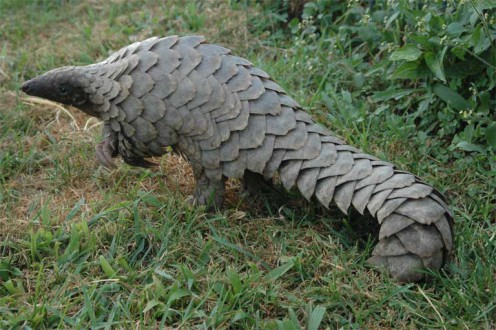
Within two days, wildlife agents secretly released the surviving 88 pangolins into an unnamed reserve. Eight had perished, and they, along with the already dead animals and scales were dumped into a pit and burned.
Customs officials across the globe regularly intercept smuggled pangolins and scales. They’re often hidden in other cargo, as with the Medan raid and another shipment found at Indonesia’s Surabaya Airport in July: 43 cartons of “fish” that contained 455 dead pangolins. Some are shipped with falsified customs declarations, as with January’s two-ton seizure of scales in Uganda that was registered as “communications equipment.”
The pangolin’s unknown plight
You may never have heard of this shy, toothless, odd creature. A pangolin looks like a primordial, armor-plated anteater — but smaller. It’s nocturnal and solitary, meeting with others only to mate. It climbs like an acrobat and can hang from trees by its long, prehensile tail, and it’s said to be able to dig through concrete with the long claws it uses to rip into termite mounds, a staple food.
Scientists know little about this elusive animal. All eight species are threatened but are rarely encountered in the wild in any of the 48 African and Asian countries where they live, which makes it nearly impossible to estimate how many remain. Nor are they often seen in zoos: They are so sensitive that few survive in captivity.
It is believed that more than a million have been killed in the last 10 years for the illegal international wildlife trade, making pangolins the most trafficked mammal on Earth. Great Britain’s Prince William recently noted that “The pangolin runs the risk of becoming extinct before most people have even heard of them.”

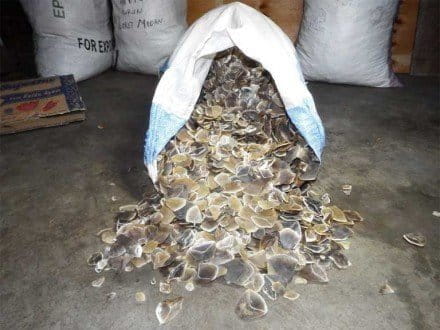
There is huge demand from consumers in China — and to a lesser degree, Vietnam — for their meat, which is often steamed with ginger and spring onion or curried. It’s a pricey delicacy that flaunts the wealth of those who dine on it or serve it to guests. Eating pangolin is believed to improve health by nourishing the kidneys; in Africa, pangolins are eaten as bushmeat.
A rising demand for pangolin, which has become a high-end luxury product, is now the greatest threat. But historically, the greatest danger to the world’s eight pangolin species has been the belief that their large, overlapping scales — made of keratin, like human fingernails and rhino horn — hold curative powers. The species name in Chinese literally means ‘animal that can dig through a hill’ and ancient lore contends that by eating this animal, one can obtain its strength and burst through the barrier of illness.
The 1597 Chinese Materia Medica prescribed dried pangolin scales (which resemble pork rinds) for excessive nervousness and hysterical crying in children, for women possessed by devils or ogres, and for malarial fever and deafness. The 1989 edition recommends the scales for treatment of everything from cancer, rheumatism and asthma to circulation problems and even acne.
In traditional Chinese medicine and African bush medicine, the pangolin fetus is consumed by men to treat flagging virility and also used to aid breastfeeding mothers. In Africa, various body parts are worn for protection and used in ritual and witchcraft, to ward off malaria, evil spirits or make it rain.
No scientific evidence supports any medicinal benefit from pangolin parts.
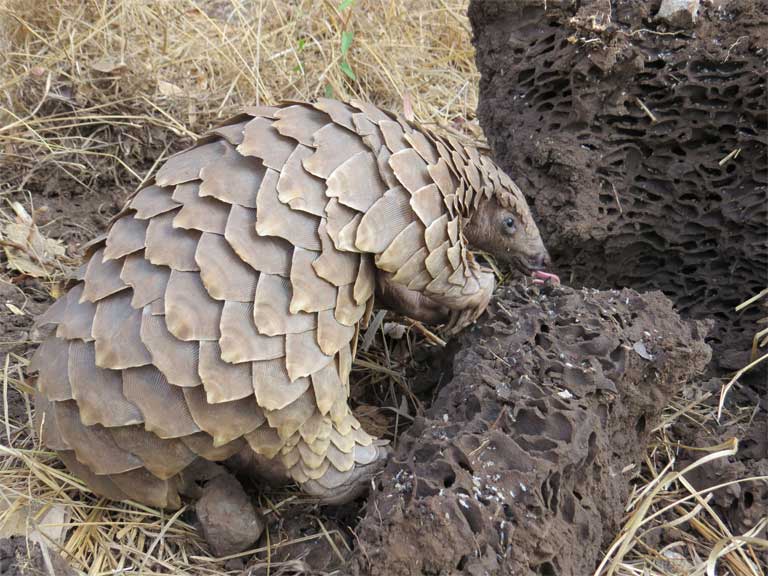
Trade in pangolins dates back centuries: King George III of England was gifted with an armored suit made from pangolin scales in 1820. More recently, tens of thousands of pangolin skins were sold internationally each year throughout the 1980s and 1990s to feed a fashion craze for pangolin leather shoes and boots. The main consumers were Japan, Mexico, and the US: 167,000 pangolins were legally exported to the United States from 1980 to 1985.
The leather trade finally stopped when parties to the Convention on International Trade in Endangered Species (CITES) adopted a “zero export quota” in 2000, banning all commercial trade in three wild-caught Asian pangolin species. CITES regulates cross-border wildlife trade under a treaty signed by 181 nations.
China’s growing thirst for pangolins
Making the trade illegal did little to stem the Chinese market. Demand for pangolin has skyrocketed in tandem with the increasing wealth of some of China’s 1.4 billion citizens. During the 1980s, up to 160,000 pangolins were being “harvested” each year, says Dan Challender, co-chair of the Pangolin Specialist Group for the International Union for Conservation of Nature (IUCN).
Once these populations became “commercially extinct,” China hoovered up Sunda pangolins from Southeast and South Asia. Both the Chinese (Manis pentadactyla) and Sunda pangolins are now Critically Endangered.
The Indian (Manis crassicaudata) and Philippine (Manis culionensis) species were targeted next. Both species are now classified as Endangered.
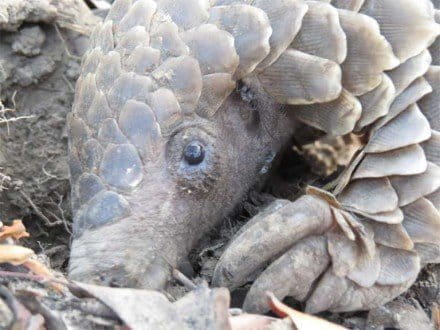
“Pangolins are in serious decline and in many locations, are gone altogether,” says Chris Shepherd, who directs the Southeast Asia office for TRAFFIC, the international wildlife trade monitoring network.
With Asian species teetering on the brink of extinction, and growing economic ties between African countries and East Asia, the harvest ground has turned to Africa. Pangolins are now flowing out of Africa to China at “industrial levels,” says Challender. This new intercontinental trade was first witnessed just six years ago, but has mushroomed because of the many Chinese development projects in Africa, he says. In 2013, all four African pangolins were placed on the endangered species list as “Vulnerable.”
Pangolins are now locally extinct in parts of Asia and Africa, and as they disappear, their value soars. Their growing rarity and price has made pangolin scales an attractive commodity for those who normally traffic elephant ivory and rhino horn, says Challender, a very worrying development.
Last year, more than six tons of African pangolin scales were seized in Asia. In the first six months of 2015, that figure jumped to eight tons. “In light of this alarming increasing trend we are realizing that these seizures represent the tip of the iceberg of a vast smuggling industry,” says Lisa Hywood, CEO and founder of the Tikki Hywood Trust, an animal rescue and conservation facility in Zimbabwe. People would be horrified, she says, if they knew how many of these animals were illegally leaving the African continent. She calls it “a grave situation.”
When you do the math, the numbers astound. Six tons of scales (12,000 pounds or 5,443 kilos) would require the slaughter of about 2,000 Temminck’s Ground Pangolin (Smutsia temminckii) or 1,000 White-bellied Pangolin (Phataginus tricuspis).
Pangolins are part of a massive, global black market wildlife trade estimated at $19 billion a year. Last March, United Nations General Assembly president Sam Kutesa called for a coordinated international response, noting that wildlife trafficking poses a serious worldwide security risk.

At a UN General Assembly Meeting in March, UN Deputy Secretary-General Jan Eliasson identified organized crime networks and rebel and terrorist groups as the perpetrators. “Illegal wildlife trade has become a mushrooming transnational form of crime, following in the footsteps of other pernicious examples, such as trafficking in human beings, in drugs and in counterfeit items,” he said.
An ancient species threatened by modern times
Challender notes that the earliest pangolin fossils date back about 80 million years. All eight of today’s species are classified in the Pholidota order, which is made up entirely of pangolins. Their genus name, Manis derives from the Latin term manes (the spirits of the dead in Roman religion), so named for their nocturnal habits and strange appearance.
“Pangolin” comes from the Malay pengguling, which means “one that rolls up,” referring to the species’ main defense. When threatened, the animal curls into an inert, scaly ball, with its tough scales shielding a vulnerable belly. This offers armored protection against even the most fearsome predators, including lions and tigers. But that defense makes pangolins an easy target for poachers, who can easily pick them up and throw them in a bag.

Scientists know little about the behaviors of these nocturnal, solitary animals. There’s been little research, and as pangolins grow rarer, they’ve become increasingly difficult to observe in the wild.
It is known that some species sleep nestled in tree hollows, while others burrow underground. They usually venture from the safety of their homes in the dark, using a keen sense of smell to compensate for poor eyesight as they scour for their favored prey, ants or termites.
Pangolins break open mounds or nests with three exceedingly long, sharp claws — so long they must tuck them under to walk. Then they insert their narrow snouts into a mound, appearing to nurse from the earth as they scoop up ants or termites with sticky tongues that in most species are longer than their entire body. Special muscles seal their nostrils and ears to keep ants out, their scales protect them from bites — and pebbles in their stomachs grind their food, like teeth.

Their foraging habits make them the gardeners of their world — and ecosystem engineers. They turn the soil and dig holes that then become homes for other species, which helps to increase that area’s species variety. They also provide pest control by downing millions of insects a year, keeping social insects in check.
How to mother a pangolin
Despite their armored appearance and introverted behavior, pangolins are extraordinary nurturers. Mothers curl up to shield or nurse their baby and cradle it to sleep. They normally bear just one “pangopup” and they carry that baby on their back or tail for its first three months. By that time, researchers believe that the young have begun eating some ants, ant eggs and a few termites. They may nurse for five or six months until they’ve been schooled in the finer points of finding and digging into ant and termite nests.
Mothers are less mobile when raising their young, says Hywood, which makes them more vulnerable to poaching. For a species that reproduces at such low rates, losing breeding-age females to traffickers further endangers the species’ survival.
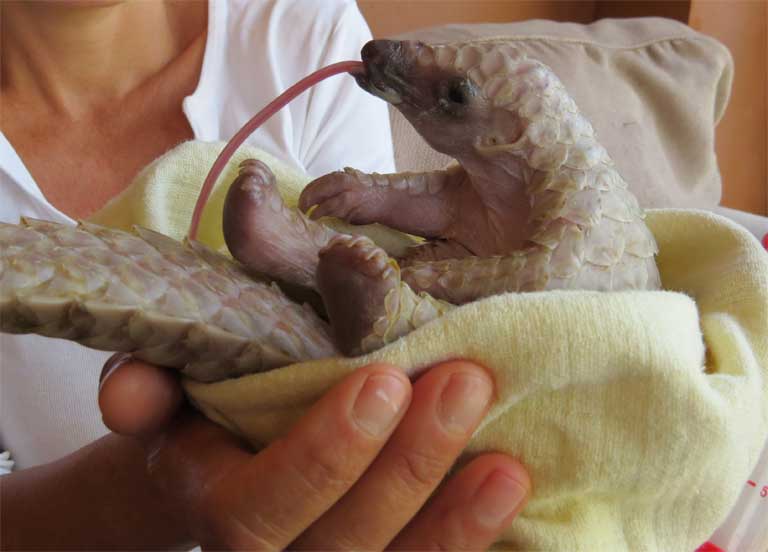
Hywood knows firsthand the difficulty of raising a pangopup. Her nonprofit has been involved in more than 50 cases where confiscated Temminck’s Ground Pangolins were sick, injured or orphaned and needed care. The goal is to raise or rehabilitate the animals for release back into the wild.
“It then becomes our responsibility to teach them how to be a pangolin,” says Hywood. Babies must be bottle-fed and taught how to live on their own. “You can’t release a pangolin without the proper skills to survive, she says, “or [release pangolins] that are so small that lions, eagles or other animals can prey on them.” A human minder becomes their surrogate mother, taking the pangopups on frequent walks, introducing them to different ant and termite species, and putting them on nests. The handler uses little tools that simulate the animal’s claws to teach the youngsters how to dig out their food.
Teaching pangopups that ants are their prey is a very slow, labor-intensive process, says Hywood. When Champ, their first orphaned pangolin, arrived at the center, he was bottle fed a specialized formula for the first three months. When it came time to wean him onto prey, researchers couldn’t get him to eat ants or termites — and couldn’t figure out why. “It’s really bizarre: Most juveniles seem to hate ants, they scratch them away if they’re crawling on them — and run off,” Hywood says. “Then, all of a sudden it clicks, ‘Hey I love ants!’ and then there is no stopping them.”

Once young pangolins learn to feed themselves and weigh at least 13 pounds (6 kilograms), the animals are released. They are then fitted with a tracking devise and monitored via radio signal until Hywood is sure that they’re ready to thrive in the wild.
Interestingly, the young animals connect with their minders long after release. “People forget that pangolins are mammals,” says Hywood. “They have a great memory and I was recently recognized by an adult female that I’d released six months before. When they develop a bond, juveniles will often stand up against your leg asking to be picked up,” she said.
Saving the world’s most trafficked mammal
Pangolins are both the most trafficked wild mammals and among the most ignored when it comes to conservation. Until recently, TRAFFIC was one of very few organizations that recognized the seriousness of what it once called “Asia’s forgotten extinction crisis.”
Suddenly, that’s changing. In 2012, the IUCN Species Survival Commission Pangolin Specialist Group was reformed. In 2013, it held the first-ever global conservation conference on pangolins, and last year launched a global action plan to conserve pangolins. At the 2014 CITES meeting, illegal trade in pangolin species was determined to be escalating at an alarming rate, and a year-round working group was established. This year, the US Fish & Wildlife Service (USFWS) identified pangolins as a conservation priority.

More and more conservation groups are coming onboard, says Challender, with pangolins starting to gain some of the attention that’s long been focused on more charismatic species like elephants, rhinos and tigers.
In June, 2015, delegates from 31 African and Asian pangolin range countries and the United States sat down for the first time to foster collaboration to conserve pangolins. The meeting, co-hosted in DaNang by the governments of Vietnam and the US and organized by Humane Society International, convened national wildlife and enforcement agencies, conservation organizations and the world’s top experts.
West, Central and Southern African countries came together, wanting to work with Asian countries. “There was this recognition that together, everyone is more powerful than one country alone taking action — because you need both importing and exporting countries to work towards solutions,” says Rosemarie Gnam, who heads the Division of Scientific Affairs for USFWS. “Countries need to stand together on this.”
A science committee chaired by Gnam determined that all eight species are in such peril that they should be uplisted to CITES Appendix 1 — its most stringent international trade rules. That would require a vote if the recommendation is put forth at the 2016 CITES meeting.
 The current “zero export” status that was placed on all four Asian species clearly is not a deterrent, says TRAFFIC’s Chris Shepherd: The illegal trade hasn’t stopped.
The current “zero export” status that was placed on all four Asian species clearly is not a deterrent, says TRAFFIC’s Chris Shepherd: The illegal trade hasn’t stopped.
Uplisting to Appendix I would bring higher profile conservation with more funding — and will restrict all commercial trade, which Shepherd characterizes as “essential.”
“As for how much has been spent on pangolin conservation, I really have no idea, but not enough!” he says. “Very little money has been put into proper research on the species in the wild, or on the impact trade is having. And, too little has been spent on enforcement support.”
Uplisting will make enforcement a priority. Most countries have laws against hunting pangolins, but with few personnel and limited funds, enforcement is generally weak and the scale of illegal trade is swamping the system. For local poachers living in poor rural areas, the lure of quick cash is extremely tempting. “Penalties need to serve as a deterrent and until this happens, the trade will continue,” says Shepherd.
In 2012, Zimbabwe enacted new wildlife legislation that includes one of the world’s strongest pangolin poaching laws. This year alone, Zimbabwe authorities have arrested and convicted 16 pangolin poachers, all of whom were given maximum sentences, nine years in prison and one of which was slapped with a US $5,000 fine.

Just a few years ago, environmental crime was low on the list of priorities for most national governments. Achim Steiner, who heads the United Nations Environment Programme; along with CITES Secretary General John E. Scanlon, and UN Development Programme Administrator Helen Clark, are urging the world to make the fight against environmental crime a priority. Wildlife crime has now gained the attention of the U.N. Security Council, General Assembly and other U.N. bodies.
While strong laws and enforcement are extremely important, reducing demand is absolutely crucial, says Challender. “Otherwise we’re going to lose Asia’s pangolins and Africa’s pangolins, and [those extinctions are] going to be attributed primarily to demand for their meat and scales — primarily from China.”
Since pangolins breed slowly and don’t often survive in captivity, it’s impossible to meet the current demand through commercial breeding — and even if that was possible, increased availability has been shown to increase demand, which further threatens wild populations.

WildAid, a San Francisco-based conservation organization, is launching a demand-reduction campaign, working with 100 media partners in China and Vietnam to raise awareness about the imperiled state of pangolins — and the impact of buying their meat and scales.
The world is realizing that pangolins are in peril, says Shepherd, and “we have an opportunity to prevent African pangolins from becoming critically endangered like they are here in Asia. It will be incredibly sad if nothing is done to protect them.”
